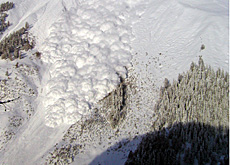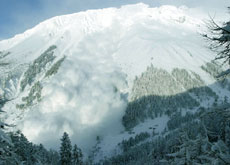Scientists stalk killer snow slides

Avalanches kill on average 25 people a year in Switzerland.
A Davos-based institute, unique in Europe, has been studying snow and avalanches for 60 years, keeping the public informed on a daily basis of the risks in the mountains.
Each year thousands of avalanches thunder down the slopes of Swiss mountains. Fortunately, most of them do not cause any damage.
But they can still prove disastrous, as in 1951 and 1999. Even in a “normal” year like 2003, for example, 21 people were killed by avalanches.
“Major avalanches exert a pressure of 20-30 tons per square metre. By way of comparison, just one ton would suffice to derail a train,” said Paul Föhn, assistant director of the Swiss Federal Institute for Snow and Avalanche Research.
“They can also reach speeds of up to 200-300kmh. And then they can easily sweep away entire villages, roads or bridges – not to mention people,” added Föhn, who has 30 years’ experience in this field.
Destructive force
Despite his vast experience, Föhn is often surprised by reality: “Ultimately, it’s not possible to predict precisely where and when avalanches will occur.”
“We can only estimate the potential risks. And suggest precautions to take.”
The institute has a staff of 130 people, including an interdisciplinary team that deals with research in three main fields: the study of snow, natural disasters, and the Alpine environment.
The scientific work is balanced out by a very familiar service in Switzerland: the daily production, during the winter months, of avalanche advisory bulletins at both the regional and national levels.
This combination of pure research and dissemination of practical information for the public makes the institute a unique centre of excellence in Europe, in particular as regards the internal synergies it is able to make.
Warning bulletins
Whole teams of people are involved in producing the avalanche bulletins, as Thomas Wiesinger, one of those responsible for the service explains.
“We work together with over 100 observers and experts all over the country who are continuously providing us with data on the stability and quantity of snow.”
“At different altitudes and locations across the Alps, we have a network of automatic devices that measure everything that can be measured: temperature, wind, etc,” Wiesinger said.
The data is transmitted electronically to the centre in Davos.
The staff then prepare avalanche bulletins in German, French and Italian which are disseminated via a number of media so as to reach the greatest possible number of people.
“We are convinced that our warnings, especially during periods of high risk, affect the behaviour of people who go into the mountains,” said Wiesinger.
Despite that, 80 to 90 per cent of the avalanches that cause damage in Switzerland are caused by skiers or hikers. People often choose to ski off-piste despite the considerable danger.
Avalanche triggers
“A multi-layered covering of snow, abundant snowfall in just a few days, strong winds and a sudden rise in temperature,” these, according to the institute experts, are the factors that give rise to avalanches.
But this is not always the case and not the only cause. “For instance, the cold is dangerous too: it multiplies the layers and makes the snow even more unstable,” explained Föhn.
And of course there is also the human factor. The pressure of just one ski or one boot in the wrong place at the wrong time can trigger a number of problems.
Wiesinger says, “the riskiest period is always the same – between the Christmas holidays and the end of February”. It is, of course, no coincidence that this goes hand in hand with the arrival of thousands of winter sports enthusiasts in the mountain regions.
Winter has now arrived. After a summer of tropical heat, drought and melting permafrost, the institute is being asked how much snow will fall this year and how many avalanches there will be.
The experts say they cannot make predictions of this type. “In our field, it is impossible to provide estimates that extend beyond a very short-term horizon,” Föhn summed up.
He hopes, for the sake of the skiers, that the blanket of snow will be sufficient. Provided, of course, that the snow doesn’t all fall from the sky at once.
swissinfo, Marzio Pescia in Davos
Avalanches kill on average 25 people a year in Switzerland.
The Swiss Federal Institute for Snow and Avalanche Research has been studying the phenomenon for 60 years and publishes daily avalanche reports in winter.
80-90% of major avalanches in Switzerland are triggered by skiers or hikers.
At least five people are estimated to have been killed by avalanches in Switzerland so far this winter.

In compliance with the JTI standards
More: SWI swissinfo.ch certified by the Journalism Trust Initiative












You can find an overview of ongoing debates with our journalists here . Please join us!
If you want to start a conversation about a topic raised in this article or want to report factual errors, email us at english@swissinfo.ch.